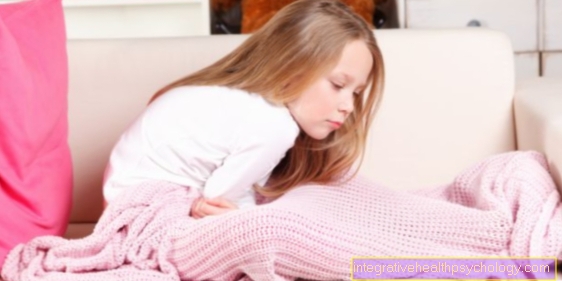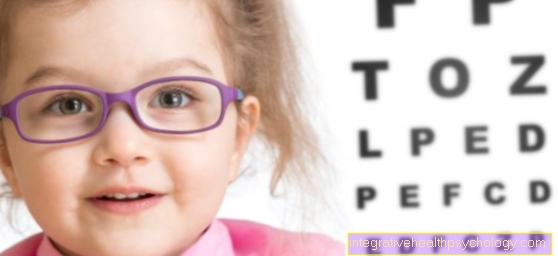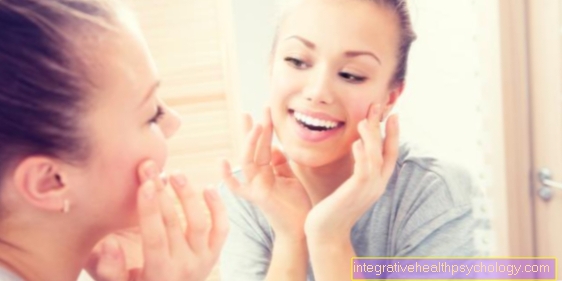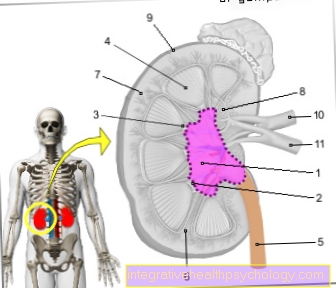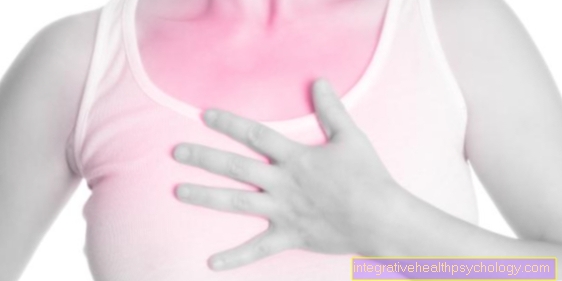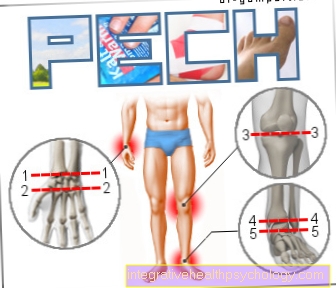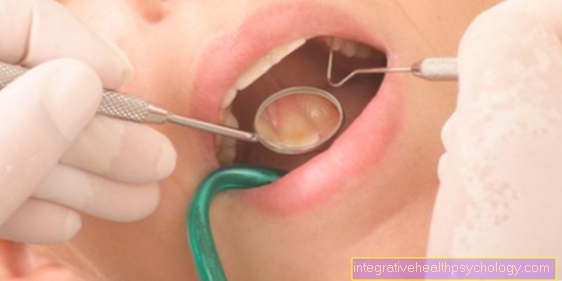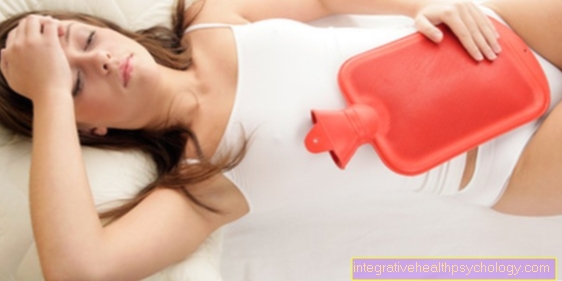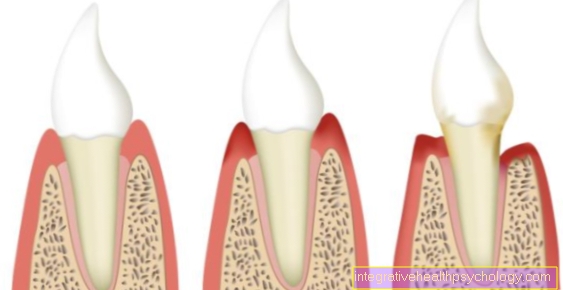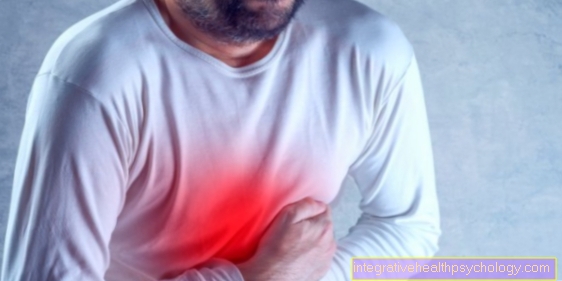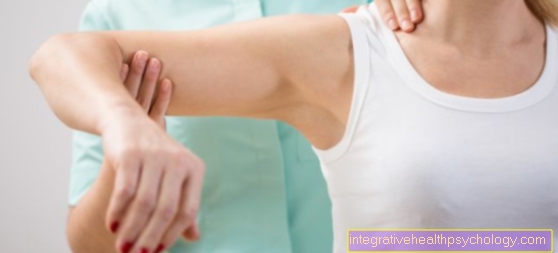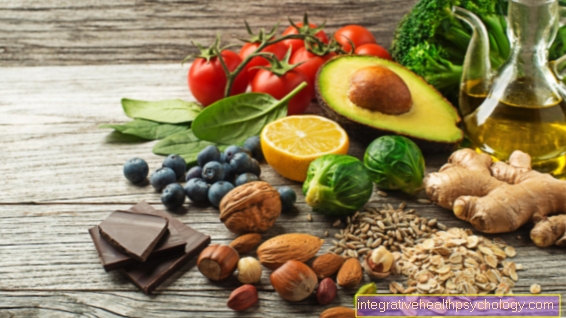Rash under the breast
definition
Many women are familiar with a reddish rash under the breast. The area under the breast is an optimal place for irritation due to the warm and slightly moist environment of the skin folds. Fungal infections are also possible. Psoriasis can also show up under the breast. Depending on the cause, the rash is not only red, it can also be itchy, scaly, or blistered. An unpleasant odor also occurs in some cases.

causes
The causes of a rash under the breast can be many. On the one hand, contact allergies should always be ruled out. If the rash occurred in connection with a new cream or a new bra, or if the detergent for the bra was changed beforehand, an attempt can be made to determine whether omitting the new agent or item of clothing leads to the rash healing.
Read more about this under Rash from an allergy
The rash often occurs in summer in conjunction with profuse sweating. The area under the breast is a fold of skin that usually has no contact with fresh air. Moisture can accumulate in this environment and a lot of heat is generated through skin contact. All of these points cause the skin to become irritated, which can show up in a rash. The irritated skin can also potentially represent a gateway for bacteria and fungi. It is therefore also possible that a rash under the breast was caused by a fungal attack.
Read more about this under Rash from sweating
Psoriasis is another possible cause. Most of the patients affected have known since childhood that they suffer from psoriasis and have already had skin changes in other parts of the body. However, these can also appear under the breast.
Read more about this under Psoriasis - The development of psoriasis
If the rash is isolated under the breasts, this usually speaks against a systemic infection as the trigger, since the skin changes would then occur less locally. Shingles is an exception. This disease, which can occur in anyone who has already had chickenpox, is caused by the same virus as chickenpox and manifests itself as a belt-shaped rash that can also run below the chest.
Read more about this under Causes of Shingles
Excessive sweating
Excessive sweating occurs under and between the breasts in many women with large breasts. The constant moisture or the loss of fluid through sweating is unfavorable for the skin. The barrier function of the skin is disturbed and irritative rashes can occur more easily. The warm and moist environment under the breasts is also an ideal breeding ground for mushrooms.
A fungal attack also manifests itself in a characteristic rash. Furthermore, sweating can also lead to inflammation of the hair follicles.
Read more about this under Skin fungus - The fungal infection of the skin
During pregnancy
Changes in hormones during pregnancy can make the skin more sensitive.In some cases, creams or washing lotions that were previously well tolerated are suddenly no longer tolerated. This can lead to a reddish rash.
Also, during pregnancy, the breasts are enlarged, which means that there is more friction under the breasts. There is also increased sweating due to hormones. This can irritate the skin under the breast and cause a rash. A fungus can also accumulate under the breasts during pregnancy if the skin folds are warm and moist.
The child is not endangered by the types of rash described.
Read more about this under
- Rash in pregnancy
- Skin changes during pregnancy
Also on the stomach
A rash on the abdomen can generally have similar causes as the rash under the breasts. For many people, skin folds also form on the stomach when they are seated, which, like the region under the chest, represent a moist and warm environment that irritates the skin.
In addition, shingles can be so extensive that it also includes the upper abdomen.
An allergy can also affect both parts of the body. Especially if the allergy is e.g. relates to a new detergent, the symptoms will appear on several parts of the body that come into contact with the washed clothes.
Infectious diseases such as The childhood diseases measles or chickenpox usually appear on the stomach and also in the chest area. Generally but not singularly under the breast.
Concomitant symptoms
A rash can generally show itself in a variety of ways. Often the accompanying symptoms also help with the diagnosis. A rash in psoriasis is usually sharply defined, reddish and scaly. In addition, in this case, other parts of the body, such as the head or extremities, skin changes.
In the case of shingles, however, there are also blisters. Itching can also exist. It also often occurs with allergic genesis. In the course of time, increased scratching can cause the sensitive and dry skin within the skin lesion to tear and painful cracks develop.
itching
Itching can be due to skin diseases or systemic diseases such as severe liver damage can be attributed. If the itchy skin change occurs locally under the breasts, this does not speak for a systemic trigger. Possible dermatological causes would be psoriasis, allergic contact eczema or a local fungal infection. Psychological stress can also lead to an increased feeling of itching.
It smells
If the rash smells bad, it could be a sign of infection. This can either be a bacterial infection or a fungal infection. The infection can also be secondary. This means that pathogenic bacteria or fungal spores get into the previously damaged, dried out and / or scratched skin, where they establish themselves and multiply.
The skin under the breast is particularly susceptible to infections, as the skin folds are constantly lying on top of one another and a warm, humid environment is formed that makes it easy for bacteria and fungi to multiply.
diagnosis
In order to be able to determine the cause of the rash with certainty, it is advisable to consult a dermatologist. This can often make the diagnosis based on the medical history or the symptoms and the specific appearance of the skin change. If a fungal infection or other infection is suspected, a smear may be taken.
In some cases it is not possible to determine with certainty what exactly caused the skin irritation. In this case, successful therapy through nursing measures is sufficient as proof that there is no chronic cause.
Treatment / therapy
Often a change in behavior is sufficient for therapy, which pays attention to intensive skin care and protection.
After every shower, the entire body, but especially the skin folds, should be dried well and then put on with cream.
In addition, moist and greasy creams help with dry eczema. Under certain circumstances, bras made from synthetic fabrics should also be avoided, as these lead to increased sweating. In addition, if you tend to sweat, you can put light gauze compresses under your chest. These absorb liquid and thus protect the skin. They can also be placed on skin that has been creamed to prevent the cream from smearing on clothing.
In the case of proven fungal attack, local therapy with a cream containing an antifungal agent is carried out. An antifungal is a drug that is targeted against fungi.
If psoriasis is present, it is usually treated externally if the infection is low. Urea, anti-inflammatory glucocorticoids, salicylic acid to loosen the scales or cignoline can be used for this. If the findings are more pronounced, internal therapy, e.g. with fumaric acid. Light therapy is also an option.
Read about it too Therapy of psoriasis
In general, the dermatologist is the best contact person for choosing the optimal skin care cream or therapy.


